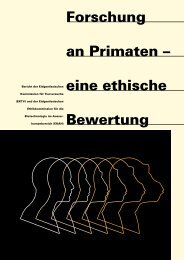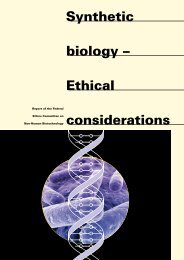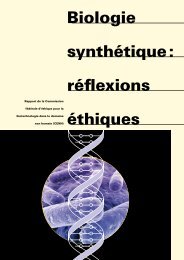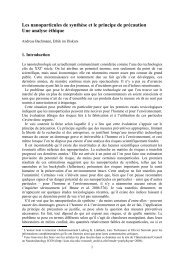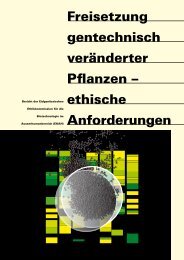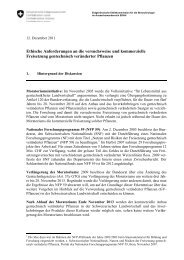Helmut Segner Fish Nociception and pain A biological perspective
Helmut Segner Fish Nociception and pain A ... - EKAH - admin.ch
Helmut Segner Fish Nociception and pain A ... - EKAH - admin.ch
- No tags were found...
Create successful ePaper yourself
Turn your PDF publications into a flip-book with our unique Google optimized e-Paper software.
perception in fish. This system may simply serve to suppress nociceptive<br />
responses, although one may wonder if this would require<br />
an apparently elaborated analgesic system.<br />
Similarities between fish <strong>and</strong> mammals extend beyond analgesia.<br />
<strong>Fish</strong> species such as zebrafish are also used as model to investigate<br />
the hedonic effects of addictive drugs as well as the mechanisms of<br />
dependence from opiate drugs (Darl<strong>and</strong> <strong>and</strong> Dowling 2001, Guo<br />
2004, Lau et al. 2006, Ninkovic <strong>and</strong> Bally-Cuif 2006). Darl<strong>and</strong><br />
<strong>and</strong> Dowling (2001) demonstrated a genetic basis for the response<br />
of zebrafish to cocaine. They showed that zebrafish exhibit strong<br />
or weak cocaine-induced conditioned place preference behaviour<br />
depending on their genetic make-up of the fish. These differences<br />
in cocaine sensitivity of behavioural preferences were associated<br />
with differences in stress sensitivity <strong>and</strong> novelty response, two<br />
para meters which in rats are associated with the dopamine system,<br />
reward behaviour <strong>and</strong> amphetamine self-administration. Selective<br />
advantages of the ability to decide for pleasure <strong>and</strong> to avoid <strong>pain</strong><br />
are obvious, <strong>and</strong> observations like the aforementioned ones raise<br />
the question on how gradually or abruptly this ability developed<br />
during vertebrate evolution.<br />
3.4 Pain perception: behavioural evidence<br />
3.4.1 <strong>Fish</strong> cognition<br />
After having discussed neuroanatomical <strong>and</strong> neurophysiological<br />
evidence for or against the capability of fish to perceive <strong>pain</strong>, this<br />
chapter will address the evidence available from behavioural studies.<br />
Animals can respond behaviourally to environmental signals<br />
in a rather inflexible, stereotypic way, or in a flexible way, what can<br />
increase the adaptive value of the response. To be able to respond<br />
in a flexible way, the animal needs advanced capabilities to process<br />
the information, memorize it, connect it with other information<br />
<strong>and</strong>/or with emotion, <strong>and</strong> to deduce logical decisions from these<br />
cognitive processes. Behavioural studies can provide insight into<br />
the mental states of animals, that is their capability to process<br />
information input <strong>and</strong> to annotate it emotionally (Bateson 1991,<br />
Rose 2002, Ch<strong>and</strong>roo 2004a, b, Broom 2007, Cottee 2012). The<br />
area of behavioural research which deals with animal minds is also<br />
designated as cognitive ethology (Bekoff 2007, Wild 2012). Intimately<br />
related to the study of animal mental states is the question<br />
of animal consciousness, however, this aspect will be discussed in<br />
a separate chapter.<br />
Concerning cognitive capabilities of fish, conventional wisdom<br />
portrays fish as simple-minded, instinct-driven organisms with<br />
“a three-second-memory” (Lal<strong>and</strong> et al. 2003, Salas et al. 2006,<br />
Braithwaite 2010), showing mainly reflexive behaviour <strong>and</strong> little<br />
cognitive capabilities (basically a behaviouristic idea – see also<br />
Wild 2012). Recent research has challenged this view <strong>and</strong> has<br />
demonstrated profound capabilities of fish for cognitive processes,<br />
for instance, fish are able to create mental representations of their<br />
social interactions <strong>and</strong> their environment (e. g., Bshary et al. 2002,<br />
Sloman et al. 2006). To cite Lal<strong>and</strong> et al. (2003):<br />
“Gone (or at least obsolete) is the image of fish as drudging <strong>and</strong><br />
dim-witted pea brains, driven largely by instinct, with what little<br />
behavioural flexibility they possess being severely hampered by an<br />
infamous three-second-memory.”<br />
It is undisputed that fish are able of simple forms of learning such<br />
as associative learning. This represents the classical “Pawlow” conditioning<br />
<strong>and</strong> operant learning, i. e. any form of learning in which<br />
a response becomes associated – via reward or punishment – with<br />
a stimulus. This form of learning represents reflexive behaviour<br />
which does not require higher cognitive capabilities. Accordingly,<br />
associative learning is already present in animals with relatively<br />
simple nervous systems such as the mollusc Aplysia (Lorenzetti<br />
et al. 2006). Thus, the presence of associative learning does not<br />
yet indicate the presence of higher cognitive capabilities in fish.<br />
However, fish execute cognitive learning processes that go clearly<br />
beyond associative learning (Bshary et al. 2002, Lal<strong>and</strong> et al. 2003,<br />
Warburton 2003, Braithwaite 2006). The evolutionary advantage<br />
of differentiated cognitive capabilities is that they enable animals<br />
to make decisions <strong>and</strong> to be able to respond to new situations in a<br />
flexible rather than in a stereotypic way (Kotrschal <strong>and</strong> Taborsky<br />
2010). <strong>Fish</strong> can recognize spatial patterns <strong>and</strong> complex temporal<br />
sequences, they memorize experiences, they display highly devel-<br />
50 <strong>Fish</strong>. <strong>Nociception</strong> <strong>and</strong> <strong>pain</strong> | Contributions to Ethics <strong>and</strong> Biotechnology<br />
<strong>Fish</strong>. <strong>Nociception</strong> <strong>and</strong> <strong>pain</strong> | Contributions to Ethics <strong>and</strong> Biotechnology<br />
51



